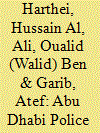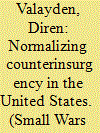|
|
|
Sort Order |
|
|
|
Items / Page
|
|
|
|
|
|
|
| Srl | Item |
| 1 |
ID:
130884


|
|
|
|
|
| Publication |
2014.
|
| Summary/Abstract |
Emergency services such as police vehicles must provide reasonable service levels in order to ensure public safety. These services are typically provided by vehicles based at fixed locations. The number and placement of vehicles generally influences the quality of services offered. Increasing the number of vehicles is often limited by cost constraints; therefore the efficient deployment of such service vehicles is a crucial issue. Emergency service vehicles must be located in such a way that they may reach any demand point within a maximal response time. Current Practices in Abu Dhabi The traffic police in Abu Dhabi perform two major functions: enforcing traffic Abu Dhabi Police Plans laws and assisting road users. Within the Abu Dhabi Police department, the Directorate of Traffic and Patrols, which is in charge of all traffic aspects, allocates the traffic patrol vehicles to routine work and to special operations. The special operations vehicles are involved in escorting convoys and motorcades and in enforcing traffic laws and regulations through the deployment of patrol officers in specific areas at certain times, or in dealing with incidents and special events. The routine patrols perform all remaining tasks. At present, the patrol car allocation process is largely manual and relies heavily on the knowledge, experience and expertise of the dispatch operators. The operators divide the Emirate into geographic zones and allocate patrols based on their knowledge about the areas' needs and other criteria such as traffic flow patterns, population density, etc. In the event of an accident or call for assistance, the dispatcher calls on one of the patrol vehicles nearby and assigns it the task of dealing with the event.
|
|
|
|
|
|
|
|
|
|
|
|
|
|
|
|
| 2 |
ID:
103478


|
|
|
|
|
| Publication |
2011.
|
| Summary/Abstract |
The events and aftermath of September 11, 2001, accelerated a search for personnel reliability test measures to identify individuals who could pose a threat to our nation's security and safety. The creation and administration of a behavioral health screen for BSL-4 laboratory workers at the National Institutes of Health represents a pioneering effort to proactively build a BSL-4 safety culture promoting worker cohesiveness, trust, respect, and reliability with a balance of worker privacy and public safety.
|
|
|
|
|
|
|
|
|
|
|
|
|
|
|
|
| 3 |
ID:
104816


|
|
|
|
|
| Publication |
London, Amnesty International, 2011.
|
| Description |
82p.
|
| Series |
Security with human rights
|
|
|
|
|
|
|
|
|
|
|
|
Copies: C:1/I:0,R:0,Q:0
Circulation
| Accession# | Call# | Current Location | Status | Policy | Location |
| 056059 | 342.546/AMN 056059 | Main | On Shelf | General | |
|
|
|
|
| 4 |
ID:
185072


|
|
|
|
|
| Summary/Abstract |
In this article, I elaborate on the thesis that counterinsurgency has become a ‘new governing paradigm’ in the United States. I first argue that the DoD redefinition of terrorism blurred the conceptual boundaries between counterterrorism and counterinsurgency, to ease the latter’s transition from the field of military strategy to that of political governance. Second, I argue that counterinsurgency became a governing paradigm, based on political techniques that worked through the subjective capabilities of the population. After 9/11, those capabilities were associated with the first responder. I trace the conceptual evolution of the first responder as a technical category in the discourse and administration of public safety, to its re-emergence in the concept of homeland security after 9/11. I argue that the political architecture created by homeland security emphasized the awareness, preparedness and resilience of the first responder who was in turn defined as the first line of defense against potential attacks. Through the first responder, counterinsurgency achieves its fundamental goal: to prevent social transformation by securing societal ‘normalcy’. Lastly, I argue that, as a governing paradigm, counterinsurgency provides a frame of interpretation to understand and categorize social experience: a first responders/insurgents schism now guides how we interpret political divisions.
|
|
|
|
|
|
|
|
|
|
|
|
|
|
|
|
| 5 |
ID:
109423


|
|
|
| 6 |
ID:
175499


|
|
|
|
|
| Summary/Abstract |
This analysis draws from security and state spending data to measure the human security experience in South Sudan. The results show a more volatile security environment following independence. Defence expenditure and human security, as measured in the number of insecurity episodes, are unrelated. Descriptive evidence indicates that human security and security expenditure tend to vary unpredictably over time, a signal that security sector spending is unresponsive to the country's security predicaments. The Ordinary Least Squares (OLS) models suggest the same: security sector spending does not contain local insecurity. Instead, more defence investment seems to correlate with insecurity; an additional 1% spent on security translates to at least 60 deaths. This finding reflects the importance of reviewing South Sudan's security sector in order to properly situate the reforms currently outlined in Chapter II of the Revitalized Agreement on the Resolution of the Conflict in South Sudan (R-ARCSS). As these reforms get implemented, security sector expenditures need strict oversight, with improved accountability measures integrated to minimise inefficiencies and foster sustainable socioeconomic and security results. Lastly, recent improvements in the security situation, as represented by significant reductions in violence, should be strategically leveraged to enable greater public confidence and trust in the recently inaugurated R-ARCSS.
|
|
|
|
|
|
|
|
|
|
|
|
|
|
|
|
| 7 |
ID:
078851


|
|
|
|
|
| Publication |
2007.
|
| Summary/Abstract |
In this paper we begin by defining and examining the concept of police building. Its historical precedents and contemporary forms are briefly reviewed, showing a variety of motives and agendas for this kind of institution building. We argue that police building has been a relatively neglected dimension of nation- and state-building exercises, despite its importance to functions of pacification and restoration of law and order. The emerging literature on international police reform and capacity building tends to adopt a narrow institutionalist and universalistic approach that does not take sufficient account of the politics of police building. This politics is multilayered and varies from the formal to the informal. Using two case studies focusing on events in 2006 in Timor-Leste and Solomon Islands, the reasons for the fragility of many current police-building projects are considered. In both cases, we argue, police capacity builders paid insufficient attention to the political architecture and milieu of public safety.
|
|
|
|
|
|
|
|
|
|
|
|
|
|
|
|
|
|
|
|
|